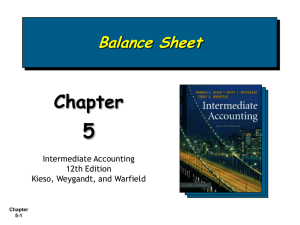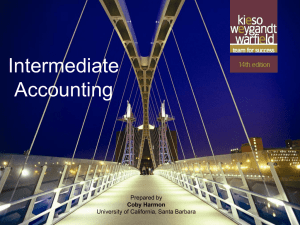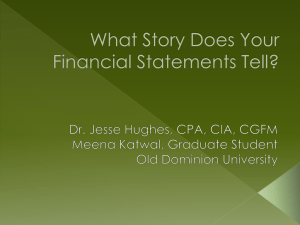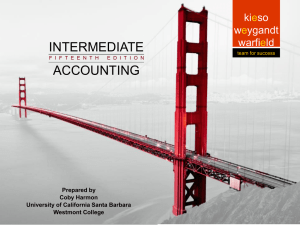Slides
advertisement
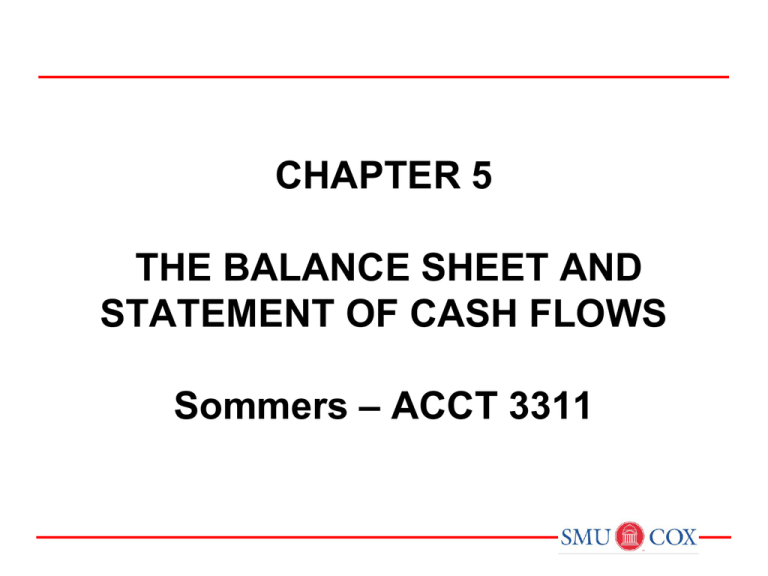
CHAPTER 5 THE BALANCE SHEET AND STATEMENT OF CASH FLOWS Sommers – ACCT 3311 The Balance Sheet • Reports a company’s financial position on a particular date. Limitations: • The balance sheet does not directly measure the market value of the entity nor its liquidation value, but it provides valuable information that can be used to help judge market value. • Resources such as employee skills and reputation are not recorded in the balance sheet. Usefulness: • The balance sheet describes many of the resources a company has for generating future cash flows. • It provides liquidity information useful in assessing a company’s ability to pay its current obligations. • It provides long-term solvency information relating to the riskiness of a company with regard to the amount of liabilities in its capital structure. Discussion Question Q5-2 What is meant by solvency? What information in the balance sheet can be used to assess a company’s solvency? Balance Sheet Classification Classification Illustration 5-1 In practice you usually see little departure from these major subdivisions. Classification in the Balance Sheet Current Assets Cash and other assets a company expects to convert into cash, sell, or consume either in one year or in the operating cycle, whichever is longer. Illustration 5-2 Balance Sheet – Current Assets Current Assets - “Summary” Cash and other assets a company expects to convert into cash, sell, or consume either in one year or in the operating cycle, whichever is longer. Balance Sheet (in thousands) Current assets Cash $ 285,000 ST Investments 140,000 Accounts receivable 777,000 Inventory 402,000 Prepaid expenses 170,000 Total current assets 1,774,000 Investments: Invesment in ABC bonds 321,657 Investment in UC Inc. 253,980 Balance Sheet – Current Assets Cash Generally any monies available “on demand.” Cash equivalents - short-term highly liquid investments that mature within three months or less. Restrictions or commitments must be disclosed. Illustration 5-3 Balance Sheet – Current Assets Short-Term and Long-Term Investments Portfolios Type Held-toMaturity Debt Trading Debt or Equity Availablefor-Sale Debt or Equity Valuation Amortized Cost Fair Value Classification Current or Noncurrent Current Adj on Inc Stmt Fair Value Adj is OCI Current or Noncurrent Balance Sheet – Current Assets Receivables Major categories of receivables should be shown in the balance sheet or the related notes. A company should clearly identify Anticipated loss due to uncollectibles. Amount and nature of any nontrade receivables. Receivables used as collateral. Balance Sheet – Current Assets Inventories Disclose: ► Basis of valuation (e.g., lower-of-cost-or-market). ► Cost flow assumption (e.g., FIFO or average cost). Illustration 5-7 Classification in the Balance Sheet Non-Current Assets Long-term Investments 1. Securities (bonds, common stock, or long-term notes). 2. Tangible fixed assets not currently used in operations (land held for speculation). 3. Special funds (sinking fund, pension fund, or plant expansion fund). 4. Non-consolidated subsidiaries or affiliated companies. Balance Sheet – Noncurrent Assets Long-Term Investments Securities Balance Sheet (in thousands) Current assets Cash $ 285,000 Investments: Invesment in ABC bonds 321,657 Investment in UC Inc. 253,980 Notes receivable 150,000 bonds, stock, and Land held for speculation 550,000 long-term notes Sinking fund 225,000 Pension fund 653,798 For marketable securities, management’s intent determines current or noncurrent classification. Cash surrender value Investment in Uncon. Sub. Total investments 84,321 457,836 2,696,592 Property, Plant, and Equip. Building Land 1,375,778 975,000 Balance Sheet – Noncurrent Assets Long-Term Investments Balance Sheet (in thousands) Current assets Cash $ 285,000 Investments: Fixed Assets Land held for speculation Invesment in ABC bonds 321,657 Investment in UC Inc. 253,980 Notes receivable 150,000 Land held for speculation 550,000 Sinking fund 225,000 Pension fund 653,798 Cash surrender value Investment in Uncon. Sub. Total investments 84,321 457,836 2,696,592 Property, Plant, and Equip. Building Land 1,375,778 975,000 Balance Sheet – Noncurrent Assets Long-Term Investments Balance Sheet (in thousands) Current assets Cash $ 285,000 Investments: Special Funds Invesment in ABC bonds 321,657 Investment in UC Inc. 253,980 Notes receivable 150,000 Land held for speculation 550,000 Sinking fund Pensions fund Sinking fund 225,000 Cash surrender value of life insurance Pension fund 653,798 Cash surrender value Investment in Uncon. Sub. Total investments 84,321 457,836 2,696,592 Property, Plant, and Equip. Building Land 1,375,778 975,000 Balance Sheet – Noncurrent Assets Long-Term Investments Balance Sheet (in thousands) Current assets Cash $ 285,000 Investments: Nonconsolidated Subsidiaries or Affiliated Companies Invesment in ABC bonds 321,657 Investment in UC Inc. 253,980 Notes receivable 150,000 Land held for speculation 550,000 Sinking fund 225,000 Pension fund 653,798 Cash surrender value Investment in Uncon. Sub. Total investments 84,321 457,836 2,696,592 Property, Plant, and Equip. Building Land 1,375,778 975,000 Balance Sheet – Noncurrent Assets Long-Term Investments Illustration 5-10 Balance Sheet Presentation of Long-Term Investments Balance Sheet – Noncurrent Assets Property, Plant, and Equipment Tangible long-lived assets used in the regular operations of the business. Physical property such as land, buildings, machinery, furniture, tools, and wasting resources (minerals). With the exception of land, a company either depreciates (e.g., buildings) or depletes (e.g., oil reserves) these assets. Balance Sheet – Noncurrent Assets Balance Sheet (in thousands) Property, Plant, and Equipment Tangible assets used in the regular operations of the business. Current assets Cash Total investments Property, Plant, and Equip. Building Land Machinery and equipment Capital leases Leasehold improvements Accumulated depreciation Total PP&E Intangibles Goodwill Patents Trademarks $ 285,000 2,696,592 1,375,778 975,000 234,958 384,650 175,000 (975,000) 2,170,386 3,000,000 177,000 40,000 Balance Sheet – Noncurrent Assets Illustration 5-11 Balance Sheet Presentation of Property, Plant, and Equipment Balance Sheet – Noncurrent Assets Balance Sheet (in thousands) Intangibles Lack physical substance and are not financial instruments. Limited life intangibles amortized. Indefinite-life intangibles tested for impairment. Current assets Cash Total PP&E Intangibles Goodwill Patents Trademark Franchises Copyright Total intangibles Other assets Prepaid pension costs Deferred income tax Total other Total Assets $ 285,000 2,170,386 2,000,000 177,000 40,000 125,000 55,000 2,397,000 133,000 40,000 173,000 $ 9,210,978 Balance Sheet – Noncurrent Assets Other Assets Items vary in practice. Can include: Long-term prepaid expenses Non-current receivables Assets in special funds Property held for sale Restricted cash or securities Balance Sheet – Noncurrent Assets Balance Sheet (in thousands) Other Assets Current assets Cash This section should include only unusual items sufficiently different from assets in the other categories. Total PP&E Intangibles Goodwill Patents Trademark Franchises Copyright Total intangibles Other assets Prepaid pension costs Deferred income tax Total other Total Assets $ 285,000 2,170,386 2,000,000 177,000 40,000 125,000 55,000 2,397,000 133,000 40,000 173,000 $ 9,210,978 Classification in the Balance Sheet Current Liabilities “Obligations that a company reasonably expects to liquidate either through the use of current assets or the creation of other current liabilities.” Balance Sheet (in thousands) Current liabilities Notes payable Accounts payable Accrued compensation Unearned revenue Income tax payable Current maturities LT debt Total current liabilities Long-term liabilities Long-term debt Obligations capital lease Deferred income taxes Total long-term liabilities Stockholders' equity $ 233,450 131,800 43,000 17,000 23,400 121,000 569,650 979,500 345,800 77,909 1,403,209 Classification in the Balance Sheet Current Liabilities Illustration 5-13 Balance Sheet Presentation of Current Liabilities Classification in the Balance Sheet Long-Term Liabilities “Obligations that a company does not reasonably expect to liquidate within the normal operating cycle.” All covenants and restrictions must be disclosed. Balance Sheet (in thousands) Current liabilities Notes payable Accounts payable Accrued compensation Unearned revenue Income tax payable Current maturities LT debt Total current liabilities Long-term liabilities Long-term debt Obligations capital lease Deferred income taxes Total long-term liabilities Stockholders' equity $ 233,450 131,800 43,000 17,000 23,400 121,000 569,650 979,500 345,800 77,909 1,403,209 Balance Sheet – Owners Equity Owners’ Equity Illustration 5-15 Balance Sheet Presentation of Stockholders’ Equity Balance Sheet Format Classified Report Form Illustration 5-16 Discussion Question Q5-4 Discuss at least two situations in which estimates could affect the usefulness of information in the balance sheet. E5-1 Balance Sheet Classification a) b) c) d) e) f) g) h) i) j) k) l) m) n) Investment in Preferred Stock Treasury Stock Common Stock Dividends Payable Accumulated Depreciation – Equipment Construction in Process Petty Cash Interest Payable Deficit Equity Investments (trading) Income Tax Payable Unearned Subscription Revenue Work in Process Salaries and Wages Payable Ratio Analysis Categories • Liquidity – Measures of the company’s shortterm ability to pay its maturing obligations. • Activity – Measures of how effectively the company uses its assets. • Profitability – Measures of the degree of success or failure of a given company or division for a given period of time. • Coverage – Measures of the degree of protection for long-term creditors and investors. Calculating Ratios Current cash debt coverage ratio Net cash provided by operating activities Average current liabilities Inventory turnover Cost of goods sold Average inventory Profit margin on sales Net income Net sales Debt to total assets Total debts Total assets Calculating Ratios Big Lots • Current cash debt coverage ratio Family Dollar 0.52 • Inventory turnover 5.05 • Profit margin on sales 4.54% • Debt to total assets 0.64 Additional information: 1. Net loss for the year was $2,500. 2. No dividends were declared during 2014. Prepare a classified balance sheet as of December 31, 2014. Debits Credits Accounts Payable $10,000 Accumulated Depreciation— Equipment 4,000 Bonds Payable (due 2021) 9,000 Cash $ ? Common Stock 10,000 Equipment 48,000 Insurance Expense 1,400 Interest Expense 900 Prepaid Insurance 1,000 Rent Expense 1,200 Retained Earnings 25,000 Salaries and Wages Expense 9,000 Salaries and Wages Payable 500 Service Revenue 10,000 Supplies (inventory) 1,200 Trademarks 950 Unearned Service Revenue 2,000 Total $ ? $ ? E5-11 Presented above is the adjusted trial balance of Kelly Corp at December 31, 2014. E5-11 E5-11

